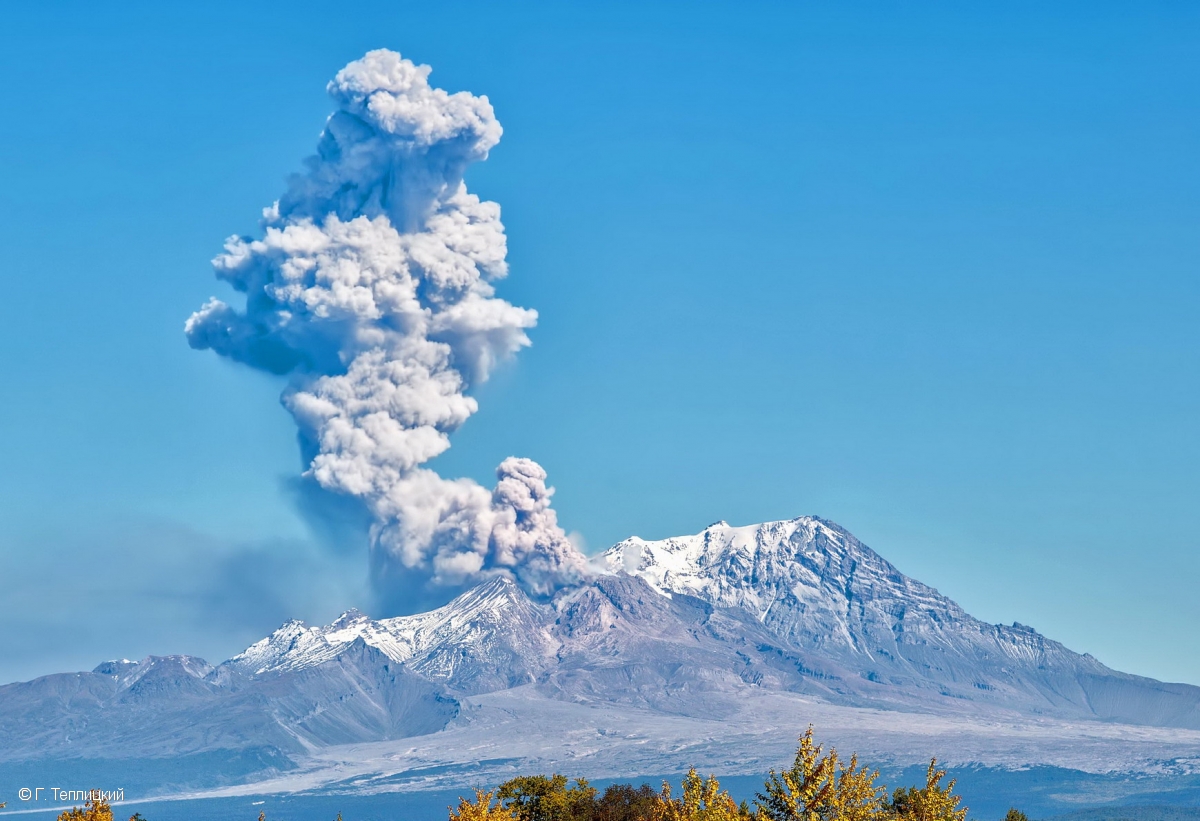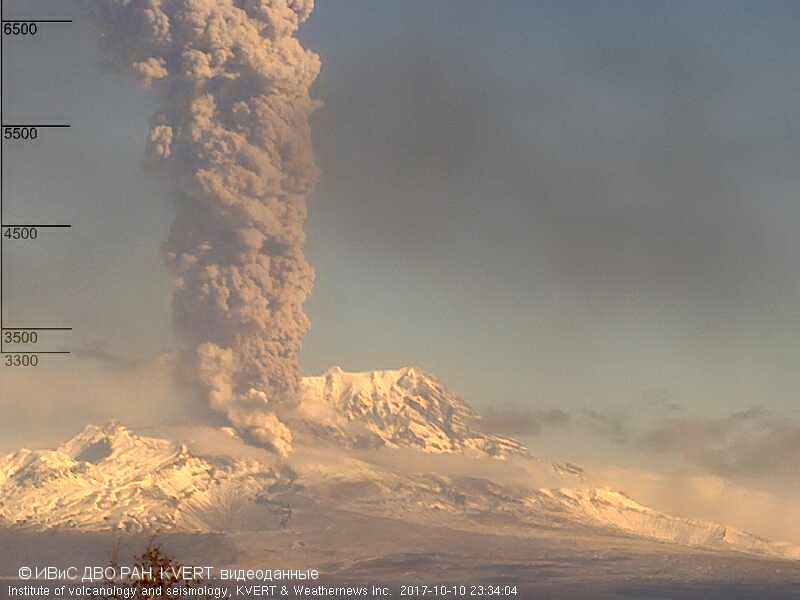Report on Sheveluch (Russia) — February 2018
Bulletin of the Global Volcanism Network, vol. 43, no. 2 (February 2018)
Managing Editor: Edward Venzke.
Research and preparation by Sara Arav-Piper.
Sheveluch (Russia) Ash explosions, pyroclastic flows, and lava dome growth continue through January 2018
Please cite this report as:
Global Volcanism Program, 2018. Report on Sheveluch (Russia) (Venzke, E., ed.). Bulletin of the Global Volcanism Network, 43:2. Smithsonian Institution. https://doi.org/10.5479/si.GVP.BGVN201802-300270
Sheveluch
Russia
56.653°N, 161.36°E; summit elev. 3283 m
All times are local (unless otherwise noted)
An eruption at Sheveluch has been ongoing since 1999, and volcanic activity was previously described through August 2017 (BGVN 42:08). Ongoing activity consists of pyroclastic flows, explosions, and lava dome growth with a viscous lava flow in the N. Strong fumarole activity, ash explosions, hot avalanches and incandescence from the dome accompany this process. Explosions and ash flows were reported by Kamchatka Volcanic Eruption Response Team (KVERT) during the August 2017 through January 2018 period.
During this report period the Aviation Color Code (ACC) remained at Orange (the second highest level on a four-color scale), except for 10 January 2018 when it was briefly elevated to Red (highest level) and lowered back to Orange later the same day. Satellite infrared data also showed increased activity on this day. Ash plume altitudes ranged from a low of 5 km to a high of 11 km on 10 January 2018. The farthest lateral extent of the ash plume was reported at 990 km to the NE on 8 November 2017.
On 4 and 8 August 2017 large ash clouds reached altitudes of 6.5 km and approximately 10 km, respectively. Ashfall was reported in Klyuchi Village (50 km SW) on 8 August and drifted about 180 km E, NW, and NE during 12 and 15-16 August. On 7 September ash plumes rose to 8-10 km altitude and drifted NE, SE, and S; another ash plume was photographed on 8 September (figure 47). On 15-22 September ash plumes rose to 9-10 km altitude and drifted about 400 km NW, E, and SE. Explosions on 10 October generated ash plumes to 10 km altitude and drifted about 250 km N (figure 48). Plumes comprised of re-suspended ash drifted about 350 km SE on 12 October and about 230 km SE on 13 October.
 |
Figure 47. Photo of an ash cloud from Sheveluch generated by an explosion on 8 September 2017. Photo by G. Teplitsky; courtesy of the Institute of Volcanology and Seismology FEB RAS, KVERT. |
 |
Figure 48. Explosions from Sheveluch sent ash up to 10 km altitude on 10 October 2017. Photo from a webcam, courtesy of the Institute of Volcanology and Seismology FEB RAS, KVERT. |
Explosions on 2 and 8 November generated ash plumes that rose to an altitude of 8 km and drifted approximately 990 km NE. Weather prevented observations on the other days from 4-10, 12-17, and 19-24 November. A strong explosive event on 5 December generated ash plumes that rose to altitudes of 10.5 km and 5 km and drifted NE and E, respectively. Explosions on 26 December generated an ash plume that rose to an altitude of 8 km and drifted about 300 km NE.
On 10 January 2018 satellite images captured an ash cloud with a dimension of 192 x 132 km drifting 230 km NE from explosions rising to altitudes of 10-11 km. In response, KVERT raised the ACC to Red. Later that same day, satellite images showed the ash cloud expanded to 350 x 180 km in dimension and had drifted 400 km E; the ACC was lowered back to Orange. The 10 January explosions began at 1035 with resulting ash that drifted about 900 km E during 10-11 January.
Thermal anomalies. As reported by KVERT, satellite imagery continue to detect the existence of a thermal anomaly over Sheveluch. The anomaly was reported on 10-30 days every month from August 2017 through January 2018. Detections of the thermal anomaly were lower in certain months because cloudy conditions obscured satellite imagery. The MIROVA system detected numerous hotspots every month during August 2017-January 2018, most of which were about 5 km or less from the summit with mainly low to a few high power signatures in August, September 2017 and January 2018. Thermal anomalies based on MODIS satellite instruments analyzed using the MODVOLC algorithm were detected in 11-12 August 2017 and 10 January 2018 corresponding to the explosive eruptions on those days.
Geological Summary. The high, isolated massif of Sheveluch volcano (also spelled Shiveluch) rises above the lowlands NNE of the Kliuchevskaya volcano group. The 1,300 km3 andesitic volcano is one of Kamchatka's largest and most active volcanic structures, with at least 60 large eruptions during the Holocene. The summit of roughly 65,000-year-old Stary Shiveluch is truncated by a broad 9-km-wide late-Pleistocene caldera breached to the south. Many lava domes occur on its outer flanks. The Molodoy Shiveluch lava dome complex was constructed during the Holocene within the large open caldera; Holocene lava dome extrusion also took place on the flanks of Stary Shiveluch. Widespread tephra layers from these eruptions have provided valuable time markers for dating volcanic events in Kamchatka. Frequent collapses of dome complexes, most recently in 1964, have produced debris avalanches whose deposits cover much of the floor of the breached caldera.
Information Contacts: Kamchatka Volcanic Eruptions Response Team (KVERT), Far East Division, Russian Academy of Sciences, 9 Piip Blvd., Petropavlovsk-Kamchatsky, 683006, Russia (URL: http://www.kscnet.ru/ivs/kvert/); Institute of Volcanology and Seismology, Far Eastern Branch, Russian Academy of Sciences (IVS FEB RAS), 9 Piip Blvd., Petropavlovsk-Kamchatsky 683006, Russia (URL: http://www.kscnet.ru/ivs/eng/); Hawai'i Institute of Geophysics and Planetology (HIGP) - MODVOLC Thermal Alerts System, School of Ocean and Earth Science and Technology (SOEST), Univ. of Hawai'i, 2525 Correa Road, Honolulu, HI 96822, USA (URL: http://modis.higp.hawaii.edu/); MIROVA (Middle InfraRed Observation of Volcanic Activity), a collaborative project between the Universities of Turin and Florence (Italy) supported by the Centre for Volcanic Risk of the Italian Civil Protection Department (URL: http://www.mirovaweb.it/).

